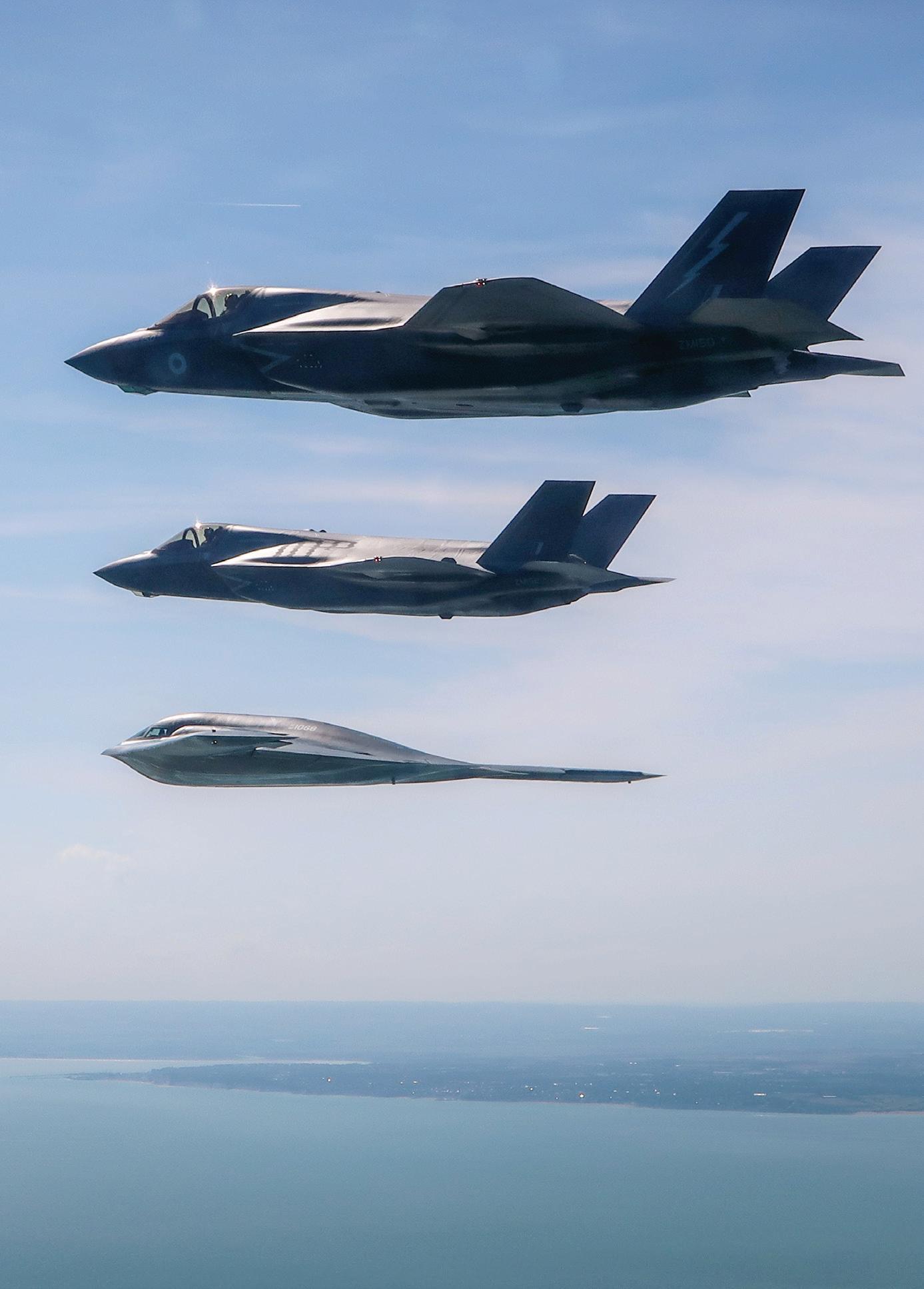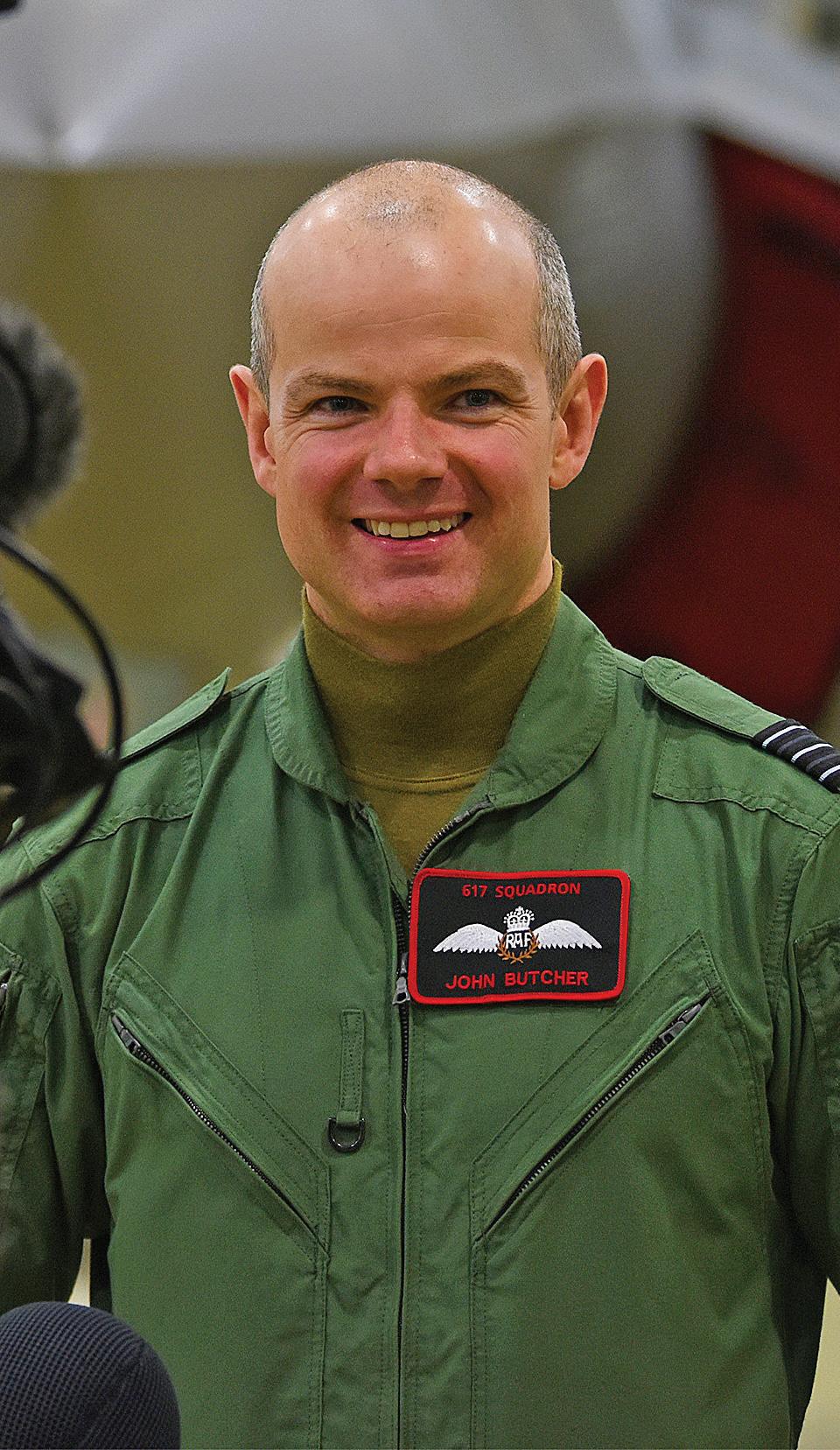
5 minute read
HMS Prince of Wales Homecoming Publication
‘DAMBUSTERS’ 617 SQUADRON
Chris Aaron speaks to Wing Commander John Butcher of 617 Squadron about preparations for the F-35B Lightning deployment to HMS Queen Elizabeth in 2021.
Late August in Norfolk. The night sky is racked by the shuddering roar and green glow of F-35B aircraft, jointly owned by the Royal Navy and the Royal Air Force, landing at RAF Marham. Three USAF B-2 Spirits land at RAF Fairford later that night, and F-35B Lightnings from the RAF’s 617 Squadron (Sqn) conduct flying integration training with them the next day, the first time any other country’s aircraft have operated alongside the B-2s. Group Captain (Gp Capt) Richard Yates, chief of staff at United Kingdom (UK) Air Battle Staff, later states: ’This flying integration builds on the work of Exercise Lightning Dawn in Cyprus and the visit of RAF F-35B Lightnings to Italy in June’.
Despite this first for the RAF, the atmosphere on base is relaxed during the drive over to 617 Sqn’s buildings, past the newly opened facilities of 207 Sqn Operational Conversion Unit (OCU) with its six aircraft and state-of-the-art simulators, into the as-yet unfinished car park, and in through the rabbit warren of corridors, to Wing Commander (Wg Cdr) John Butcher’s office, his windows overlooking the trees and humped shelters of the squadron’s nine F-35B Lightnings.
Dambusters Reborn
617 Sqn ‘The Dambusters’ was stood up as an operational squadron at a ceremony in Washington, DC on April 18, 2018. General Stephen Wilson, vice chief of staff for the US Air Force said at the time, ‘The Dambusters will be flying the F-35 Lightning, a fifth-generation air fighter ready to deter and win. We will take it to the skies together again’.

Pictured are four of Britain’s new cuttingedge F-35B aircraft, flying over the UK in June 2018. The first of Britain’s new aircraft arrived into RAF Marham, their new home in Norfolk, touching down late in the evening after a trans-Atlantic flight from the United States, where Britain has more of the jets and 150 personnel in training.
Crown Copyright
Four of the squadron’s aircraft took to the skies from US Marine Corps Air Station Beaufort for the 10-hour transatlantic flight to RAF Marham on June 6, 2018, and six months later the squadron achieved Initial Operating Capability (IOC) Land on Jan. 10, 2019. Meanwhile, on Sept. 28, 2018, two F-35Bs flown by Royal Navy and RAF pilots based at Beaufort had touched down on the deck of HMS Queen Elizabeth as the aircraft carrier exercised on the eastern seaboard of the United States. That landing marked the beginning of two months of trials, which also included establishing the limits of weather conditions for safe landing on board the UK’s Queen Elizabeth-class carriers. The next milestone for the squadron’s operational development was the six-week deployment to RAF Akrotiri in Cyprus on May 23, 2019. ‘Lightning Dawn’ involved tactical flight training and live-fire exercises, but most importantly, it proved the logistical capability of the squadron, with its technicians, support, and operations staff, to operate effectively from a remote base.
During Lightning Dawn, the squadron carried out its first combat operation on June 16, providing armed overwatch to ground forces over Syria and Iraq as part of Operation Shader. On the way back to Marham, two of the squadron’s aircraft stopped off at the Italian Air Force base Amendola, to take part in drills with US and Italian F-35As. Part of this exercise was to practise use of the F-35’s Multi-function Advanced Data Link (MADL) – the system that enables situational awareness data to be shared between assets such as the F-35, F-22, B-2, and naval vessels equipped with Aegis combat systems. As several F-35 pilots have noted, the level of situational awareness provided to the pilot by the F-35’s internal and linked systems is one of the platform’s greatest advances and advantages.

A United States Air Force B-2 Spirit, deployed to RAF Fairford in Gloucestershire, flies above the English countryside near Dover with two RAF F-35B jets.
Image Captured by a USAF Exchange Pilot
Against this background, Butcher has a clear picture of the immediate priorities for 617 Sqn. In September, ’the whole squadron is flying from here as part of Exercise Cobra Warrior’, then ‘we are sending a contingent of personnel and aircraft to HMS Queen Elizabeth in October for Operational Testing (OT-1) which is the number one objective of the “WESTLANT 19” deployment. The final figure is to be defined, but I think it will be up to 70 personnel in total, two pilots and up to five aircraft. We also have Red Flag in the mix, coming up in January, and that is also a very high priority for us. That will be the first time we have flown in that kind of complex environment: it is clearly the best combat air exercise in the world’. On top of these immediate priorities, Butcher has a carefully planned strategy for the longerterm objectives relating to preparations for HMS Queen Elizabeth’s first operational deployment – 2021 Carrier Strike Group (CSG21). This will see UK F-35Bs embarked alongside a contingent of USMC F-35Bs. ’What we’ve been doing since we arrived at RAF Marham is maintaining a readiness state across all our mission sets – the F-35 has got a pretty broad portfolio. Then adding the carrier in there as well is a new thing for us over the next couple of years’. He continues,

Wg Cdr John Butcher answers questions during a media day for Exercise Point Blank 18-3 at Royal Air Force Lakenheath, England, in November 2018.
U.S. Air Force Photo by Staff Sgt. Alex Echols
‘CSG21 is very important, but for the squadron, 2020 is actually more important because we have got to do four carrier qualifications for all of the squadron pilots in the summer of 2020 and then do the Group Sail test period in the Autumn of 2020, which is essentially the proving ground for us being able to operate together properly on CSG21’.
’As part of WESTLANT 19, OT-1 is a great opportunity for us to get some early exposure as a squadron, and providing the resource to that is very important’, notes Butcher. ‘What we’ve done is identify the key posts that we want to give that early exposure to, so that it will be the right leadership to take 617 Sqn to the carrier for qualification and Group Sail next year’. Butcher himself will be moving to a new post before then. ’We’ve got the right level of experience from previous platforms trying to drive that forward: I’ve flown off a carrier in the Harrier and in the F-18 Hornet, so I’ve seen that kind of operating environment before, and I know what to expect’. He concludes by reiterating just how important HMS Queen Elizabeth’s first operational deployment will be for the Dambusters, ‘CSG21 is ultimately what it’s about for us over the next two years or so. We’ve got a lot that we’ve got to get through to get there’.










